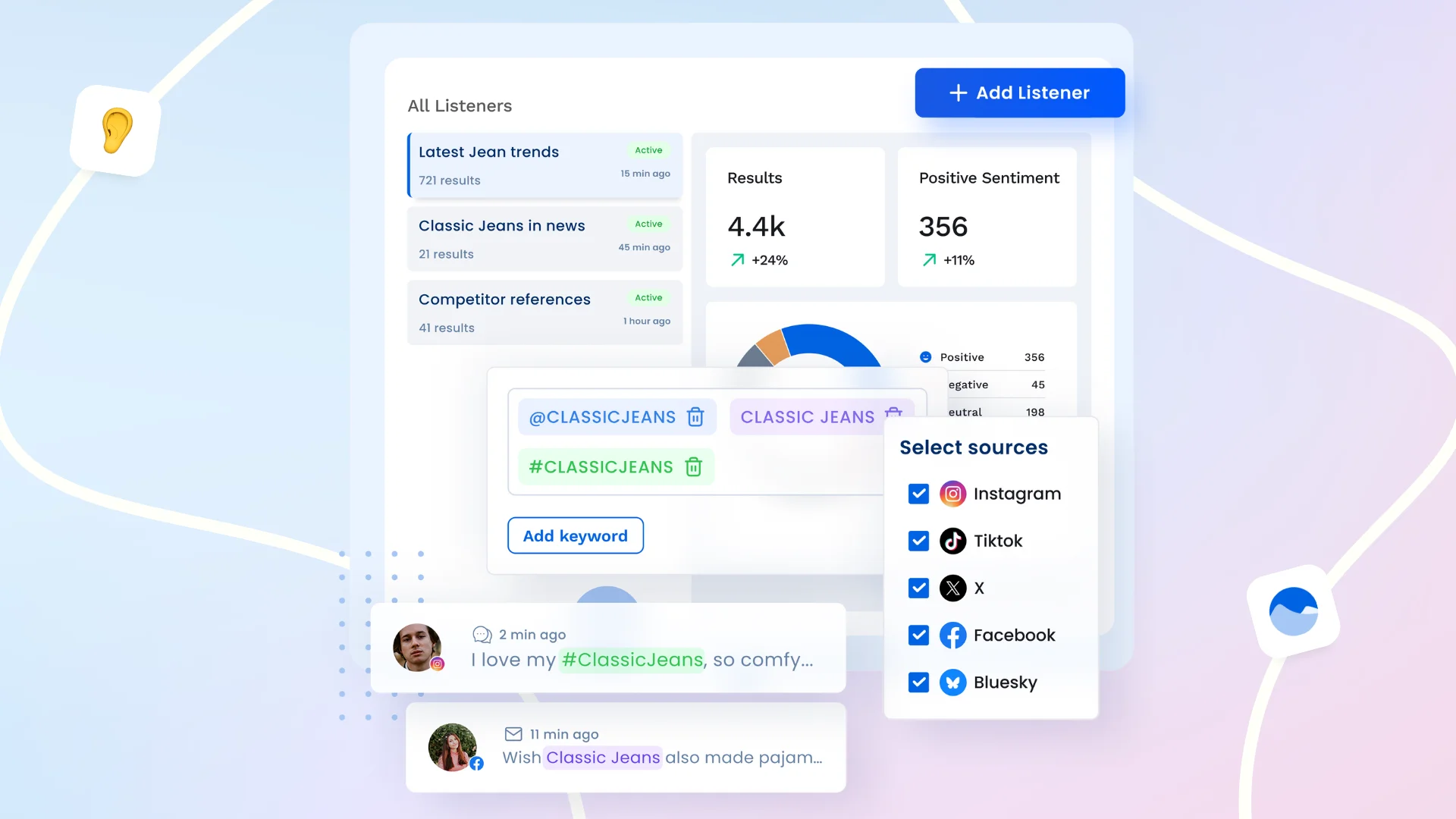New

Social Listening Made Simple: How to Use It for Brand Growth
Learn why social listening is no longer just for big brands and how Vista Social makes it affordable for creators, agencies, and small businesses.

How Something Social Saved 75% of Their Time and Increased Revenue by 15%
See how a fast-growing agency improved operations, cut down hours of manual work, and unlocked new revenue opportunities with Vista Social.
New

50 Unique Social Media Ideas for Consistent Content Creation
Discover 50 unique social media post ideas to engage your audience, grow your brand, and maintain a consistent content strategy with ease!
Sentiment Analysis Marketing: Crucial Tips and Techniques
Updated on September 27, 2024
7 min to read
Content Writer
Published September 30, 2024


Content
Share

Ever wished you could read your customers’ minds? Well, sentiment analysis marketing is the next best thing to telepathy. It’s like taking your audience’s pulse, sifting through tons of data to figure out if people are happy, upset, or somewhere in between.
With 69% of customers expecting companies to read their complaints on X, it’s clear people want to be heard. That’s when you dig deeper to uncover the emotions behind those gripes.
Knowing how your customers feel lets you spot problems early, find out what people love about your brand, and tailor your message to hit the right emotional notes.
In short, sentiment analysis in your marketing turns guesswork into insight, helping you make smarter marketing moves based on real customer feelings. In today’s cutthroat market, that’s how you stay ahead of the game. Ready to dive deeper into how it works?
Table of contents
What Is Sentiment Analysis Marketing?
Sentiment analysis marketing is a technique that uses artificial intelligence to interpret and classify emotions in text data, revealing how people truly feel about your brand, products, or campaigns.
Why does this matter? Because emotions drive decisions, and decisions drive sales. When marketers know what makes their audience tick and what areas need improvement, they can create more effective campaigns, improve products, and build stronger relationships with customers.
It’s like having a direct line to the audience’s feelings, helping marketers in craft messages and experiences that truly resonate.
[Must Read: Social Media Sentiment Analysis: A Comprehensive Guide]
Incorporating Sentiment Analysis in Marketing
Want to learn how Sentiment Analysis Marketing helps marketers stay one step ahead of the market trends? Below, we’ll explore the key benefits and applications of this powerful analytical tool.
Monitor Brand and Assess Public Perception
Sentiment analysis helps you keep a finger on the pulse of your brand’s reputation without having to manually read every comment. Imagine being able to tune into all the chatter on social media, reviews, and online forums. Cool, right?
This nifty tool helps marketers get a real-time feel for how folks view their brands, products, or services.
Say there’s a sudden flood of negative comments, could be a product issue or customer service mistake. But no worries! You can jump on it before it gets out of control. And when people are loving what you’re doing? You’ll know that too.
Enhance Messaging and Feedback from Campaign Insights
You know how sometimes you’re not sure if your ads are hitting the mark? Well, this is where sentiment analysis comes in handy. By applying sentiment analysis to campaign-related data, marketers can fine-tune their messaging for maximum impact.
For example, analyzing social media reactions to different ad variations can reveal which elements (e.g., tone, visuals, or messaging) elicit the most positive responses. These insights enable marketers to optimize their campaigns in real-time, allocating resources more effectively and improving overall campaign performance.
Capture Genuine Customer Voices Through Social Listening
Social listening, powered by sentiment analysis, enables marketers to tap into authentic customer conversations and opinions. By monitoring social media platforms, forums, and review sites, companies can gain unfiltered insights into customer experiences, pain points, and desires.
For example, a skincare brand might use social listening to track conversations on Twitter and Instagram about their new moisturizer. Through sentiment analysis, they notice a recurring negative sentiment where customers mention the product causing irritation for sensitive skin.
This insight allows the brand to quickly address the issue by releasing a statement, offering solutions, and even reformulating the product if necessary.
Convert Feedback into Strategy Through Market Research
Sentiment analysis can significantly enhance traditional market research efforts by providing a more comprehensive view of customer opinions. Spot trends before they explode, decode what really makes your customers tick, and validate your hunches with hard data.
It’s the difference between guessing and knowing. Take product reviews, for instance. Sentiment analysis can pinpoint exactly what features make your customers swoon, guiding your next big innovation.
Discover and Spot Influencers That Supports You
Identifying and collaborating with the right influencers is crucial for many marketing strategies. Sentiment analysis can help marketers discover influencers who genuinely align with their brand values and resonate with their target audience.
Imagine knowing not just how many likes an influencer gets, but how people really feel about their posts. Are followers genuinely excited or just scrolling by? This helps marketers pick partners who truly vibe with their brand and audience.
Analyze Competitors and Gain Insights from Rivals
Sentiment analysis isn’t limited to monitoring a company’s brand; it can also provide valuable insights into competitors’ performance and strategies. By analyzing sentiment around competitor brands, products, and campaigns, marketers can spot gaps they’re missing, learn from their wins and flops, and refine their strategies accordingly.
Try Vista Social for Free
A social media management platform that actually helps you grow with easy-to-use content planning, scheduling, engagement and analytics tools.
Get Started NowTechniques in Conducting Sentiment Analysis
Sentiment analysis generally employs one of three primary techniques or analytical approaches. Here’s a quick summary of each technique:
Integrate Sentiment Analysis with Marketing Automation
Integrating sentiment analysis with marketing automation allows businesses to streamline how they monitor and respond to customer emotions. Automated systems use machine learning to assess sentiment by analyzing inputs like customer reviews, social media posts, and other online conversations.
These systems continue to learn and improve over time, offering increasingly accurate sentiment classifications—positive, negative, or neutral. While setting up these automated processes can be more complex and time-consuming, the benefit lies in their ability to understand context.
Example: An e-commerce platform could automatically send a support email when negative sentiment is detected in a product review.
Rule-Based Systems
Rule-based systems use predefined rules to classify sentiment:
- Keyword spotting: Identify specific words or phrases associated with positive or negative sentiment.
- Lexicons: Use dictionaries of words with pre-assigned sentiment scores.
- Linguistic rules: Apply grammatical structures to understand context (e.g., negations).
Rule-based text analysis has several advantages and disadvantages. On the positive side, it is simple to implement and effective for straightforward text. However, it struggles with complex language and context, including sarcasm. It also requires frequent updates to rules and keywords to maintain accuracy.
Example: A rule might classify a review containing “great” as positive, but miss the sarcasm in “great, another delay.”
Hybrid Methods
Hybrid methods combine rule-based systems with machine learning, providing greater accuracy, especially when dealing with complex language and contextual nuances. These models also can improve over time as they are exposed to more data, continually enhancing their performance and adaptability.
For this reason, marketing professionals often find the greatest value in tools that combine multiple approaches–hybrid methods.
Vista Social: Your Partner in Sentiment Analysis
Vista Social offers a comprehensive suite of tools designed to help marketers and businesses leverage sentiment analysis effectively. The platform includes key features such as social media listening and monitoring, automated sentiment classification of posts and comments, sentiment trend tracking over time, and detailed sentiment analysis reports and visualizations.
Vista Social offers a suite of tools designed to help marketers and businesses leverage sentiment analysis effectively.
- Real-time sentiment alerts: Instant notifications when significant changes in sentiment occur, allowing quick responses to emerging trends or issues.
- Sentiment filtering: Ability to sort and view content based on specific sentiment categories (positive, negative, neutral), enabling focused analysis.
- Sentiment trend tracking: Visualization of sentiment changes over time, helping identify patterns and long-term shifts in public opinion.
- Sentiment intensity scoring: Numerical ranking of sentiment strength, allowing for more nuanced understanding beyond simple positive/negative categorization.
- Topic-based sentiment analysis: Breaking down sentiment by specific topics or keywords, providing granular insights into different aspects of a brand or campaign.
- Multilingual sentiment analysis: Ability to analyze sentiment across multiple languages, expanding the scope of global brand monitoring.
By utilizing these features, marketers can process large volumes of social data to detect overall sentiment trends as well as more nuanced emotional reactions. This enables marketers to make data-driven decisions, refine their social media strategies, and respond promptly to changes in public opinion.
So, whether you’re looking to fine-tune your brand’s online persona or just stay ahead of the social media curve, Vista Social’s got your back.
[Must Read: Social Media Sentiment Analysis by Vista Social]
Utilize Sentiment Analysis Marketing Now
Sentiment analysis is more than just a marketing buzzword—it’s a powerful tool that can transform how you understand and connect with your audience.
Don’t let this powerful tool sit on the shelf. Start small if you need to—maybe by monitoring sentiment around a specific product or campaign. As you get comfortable with the insights, expand your efforts. Use the strategies and techniques we’ve discussed to fine-tune your messaging, improve customer experiences, spot trends before your competitors, and build stronger, more authentic connections with your audience
The bottom line? Sentiment Analysis Marketing turns the vast sea of customer opinions into actionable insights. It’s like having a direct line to your customers’ emotions, helping you make smarter, more empathetic marketing decisions.
Take the leap. Implement sentiment analysis in your marketing strategy. Your brand—and your customers—will thank you for it.
P.S. If you’re new here, Vista Social is an all-in-one social media management solution tailored for marketing professionals, including agencies, freelancers, and social media managers. Our platform offers sophisticated features to boost teamwork, streamline processes, and maximize the impact of your social media marketing efforts.
Sign up for Vista Social today to discover our suite of tools and take your social media strategy to the next level!
FAQs on Sentiment Analysis Marketing
How accurate is sentiment analysis?
Accuracy can vary, typically ranging from 70-90%, depending on the complexity of the text and the sophistication of the analysis tool. Hybrid methods combining rule-based systems and machine learning tend to be more accurate than simpler approaches.
About the Author
Content Writer
Content writer and copywriter with over 2 years of experience, specializing in VSL scriptwriting. I’ve worked with various brands to create compelling content. Passionate about storytelling that connects and converts. Loves cats, poetry, and skincare
Never Miss a Trend
Our newsletter is packed with the hottest posts and latest news in social media.

You have many things to do.
Let us help you with social media.
Use our free plan to build momentum for your social media presence.
Or skip ahead and try our paid plan to scale your social media efforts.
P.S. It will be a piece of cake 🍰 with Vista Social
Subscribe to our Newsletter!
to stay updated on the latest and greatest Social Media news
We promise not to spam you!


